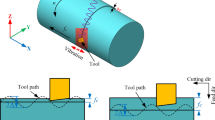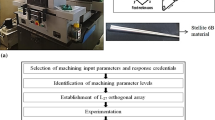Abstract
To enhance the effectiveness of jet polishing, ultrasonic coupled abrasive jet polishing (UC-AJP) was applied. Through high-frequency ultrasonic vibration, pressure lower than saturated vapor was generated in the jet. It made the jet medium cavitation; thus, cavitation-jet composite energy enhanced the material removal rate and reduced the roughness of the workpiece surface. Firstly, the principle of UC-AJP was analyzed, and a numerical model of UC-AJP was established according to the shear-stress transport (SST) k-ω turbulence model, Schnerr-Sauer cavitation model, and discrete phase model (DPM). Through the numerical calculation, the cavitation was enhanced with the increase of ultrasonic amplitude. When the amplitude reached 20 μm, the cavitation bubbles acted on the workpiece surface. Cavitation also increased the velocity and turbulent kinetic energy of the jet. Then, cavitation observation experiments were carried out; the results were consistent with the numerical simulation. Through the fixed-point polishing experiments, it was found that the erosion effect of UC-AJP on the workpiece was enhanced and then weakened. Through continuous polishing experiments, the surface of the workpiece was the smoothest after the polishing with amplitude 20 μm, the roughness decreased from 3.2 μm to 69 nm, and the speed of roughness reduction was also the fastest.






















Similar content being viewed by others
Data availability
Data will be made available on reasonable request.
References
Wu Z, Shen J, Peng Y, Wu X (2022) Review on ultra-precision bonnet polishing technology. Int J Adv Manuf Technol 121(5):2901–2921
Gisario A, Barletta M, Veniali F (2022) Laser polishing: a review of a constantly growing technology in the surface finishing of components made by additive manufacturing. Int J Adv Manuf Technol 120(3):1433–1472
Faehnle O, Rascher R, Vogt C, Kim DW (2018) Closed-loop laser polishing using in-process surface finish metrology. Appl Optics 57(4):834–838
Serhatlioglu M, Ortaç B, Elbuken C, Biyikli N, Solmaz ME (2016) Co2 laser polishing of microfluidic channels fabricated by femtosecond laser assisted carving. J Micromech Microeng 26(11):115011
Krishnan A, Fang F (2019) Review on mechanism and process of surface polishing using lasers. Front Mech Eng-prc 14(3):299–319
Kumar M, Das M (2022) Impact of different magnetorheological fluid compositions on poppet valve profile polishing. Precis Eng 76:75–87
Rampal R, Goyal T, Goyal D, Mittal M, Kumar Dang R, Bahl S (2021) Magneto-rheological abrasive finishing (maf) of soft material using abrasives. Mater Today: Proc 45:5114–5121
Ge J, Li C, Gao Z, Ren Y, Xu X, Li C, Xie Y (2021) Softness abrasive flow polishing method using constrained boundary vibration. Powder Technol 382:173–187
Mohseni-mofidi S, Pastewka L, Teschner M, Bierwisch C (2022) Magnetic-assisted soft abrasive flow machining studied with smoothed particle hydrodynamics. Appl Math Model 101:38–54
Qiao S, Shi F, Tian Y, Song C, Tie G, Shen X, Song J (2022) Modeling and experiment on elastic region low defect jet polishing for fused quartz. J Manuf Process 77:831–837
Chen F, Wang H, Tang Y, Yin S, Huang S, Zhang G (2018) Novel cavitation fluid jet polishing process based on negative pressure effects. Ultrason Sonochem 42:339–346
Natarajan Y, Murugasen PK, Sundarajan LR, Arunachalam R (2019) Experimental investigation on cryogenic assisted abrasive water jet machining of aluminium alloy. Int J Pr Eng Man-gt 6(3):415–432
Choudhary S, Kumar Duvedi R, Singh Saini J (2022) Effect of material removal characteristics with varying incident angle in fluid jet polishing process. Mater Today: Proc 62:215–219
Qiao S, Shi F, Tian Y, Jiao Z, Yang P, Zhang W (2022) Numerical and experimental investigations on nano-sio2 jet polishing efficiency by different nozzle structures. Ceram Int 48(11):15603–15612
Zhao J, Xiang Y, Fan C (2022) A new method for polishing the inner wall of a circular tube with a soft abrasive rotating jet. Powder Technol 398:117068
Zhao J, Huang J, Wang R, Peng H, Hang W, Ji S (2020) Investigation of the optimal parameters for the surface finish of k9 optical glass using a soft abrasive rotary flow polishing process. J Manuf Process 49:26–34
Ge J, Hu W, Xi Y, Ren Y, Xu X, Zhang C (2021) Gas-liquid-solid swirling flow polishing and bubble collapse impact characteristics. Powder Technol 390:315–329
Zhang L, Ding C, Han Y, Zhang Z, Fan C (2022) Investigation into a novel pulsating cavitation air jet polishing method for ti-6al-4v alloy. Tribol Int 175:107837
Lv Z, Hou R, Zhang Z, Fan Z (2020) Effect of ultrasonic vibration on cavitation erosion of aluminum oxide in fluid jet machining. Int J Adv Manuf Technol 111(9):2911–2918
Beaucamp A, Katsuura T, Takata K (2018) Process mechanism in ultrasonic cavitation assisted fluid jet polishing. Cirp Ann-manuf Techn 67:361–364
Beaucamp A, Katsuura T, Kawara Z (2017) A novel ultrasonic cavitation assisted fluid jet polishing system. Cirp Ann-manuf Techn 66(1):301–304
Ge J, Ren Y, Li C, Li Z, Yan S, Tang P, Xu X, Wang Q (2023) Ultrasonic coupled abrasive jet polishing (uc-ajp) of glass-based micro-channel for micro-fluidic chip. Int J Mech Sci 244:108055
Menter FR (1994) Two-equation eddy-viscosity turbulence models for engineering applications. Aiaa J 32(8):1598–1605
Huang H, Sun T, Zhang G, Sun L, Zong Z (2018) Modeling and computation of turbulent slot jet impingement heat transfer using rans method with special emphasis on the developed sst turbulence model. Int J Heat Mass Tran 126:589–602
Li L, Xu WX, Tan YF, Yang Y, Yang JG, Tan DP (2023) Fluid-induced vibration evolution mechanism of multiphase free sink vortex and the multi-source vibration sensing method. Mech Syst Signal Pr 189:110058
Zhao J, Jiang E, Qi H, Ji S, Chen Z (2020) A novel polishing method for single-crystal silicon using the cavitation rotary abrasive flow. Precis Eng 61:72–81
Li L, Lu B, Xu WX, Gu ZH, Yang YS, Tan DP (2023) Mechanism of multiphase coupling transport evolution of free sink vortex. Acta Phys Sin 72(3):182–195
Fu X, Li D, Wang H, Qin D, Wei X (2023) Cavitation mechanism and effect on pump power-trip transient process of a pumped-storage unit. J Energy Storage 66:107405
Koksal CS, Usta O, Aktas B, Atlar M, Korkut E (2021) Numerical prediction of cavitation erosion to investigate the effect of wake on marine propellers. Ocean Eng 239:109820
De Giorgi M, Fontanarosa D, Ficarella A (2019) Characterization of unsteady cavitating flow regimes around a hydrofoil, based on an extended Schnerr-Sauer model coupled with a nucleation model. Int J Multiphas Flow 115:158–180
Parker MJ, Savory E, Straatman AG (2022) Statistically accurate discrete phase modelling of particle cloud generation using aggregate steady random particle injection. Powder Technol 411:117959
Li A, Ahmadi G (1992) Dispersion and deposition of spherical particles from point sources in a turbulent channel flow. Aerosol Sci Technol 16(4):209–226
Funding
This work was supported by National Natural Science Foundation of China (51875526), Natural Science Foundation of Zhejiang Province (LY22E050008), Support Foundation of Zhejiang Provincial Key Research and Development Lingyan Program (2022C01096), and Eyas Program Incubation Project of Zhejiang Provincial Administration for Market Regulation (CY2022221).
Author information
Authors and Affiliations
Contributions
These authors contributed equally to this work.
Corresponding author
Ethics declarations
Ethics approval
Not applicable.
Consent to participate
Not applicable.
Consent for publication
Not applicable.
Competing interest
The authors declare no competing interests.
Additional information
Publisher's Note
Springer Nature remains neutral with regard to jurisdictional claims in published maps and institutional affiliations.
Rights and permissions
Springer Nature or its licensor (e.g. a society or other partner) holds exclusive rights to this article under a publishing agreement with the author(s) or other rightsholder(s); author self-archiving of the accepted manuscript version of this article is solely governed by the terms of such publishing agreement and applicable law.
About this article
Cite this article
Li, Z., Ge, J., Li, X. et al. Numerical and experimental study on cavitation enhancement of ultrasonic coupled abrasive jet polishing. Int J Adv Manuf Technol 131, 5769–5786 (2024). https://doi.org/10.1007/s00170-024-13253-z
Received:
Accepted:
Published:
Issue Date:
DOI: https://doi.org/10.1007/s00170-024-13253-z




